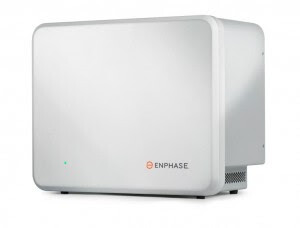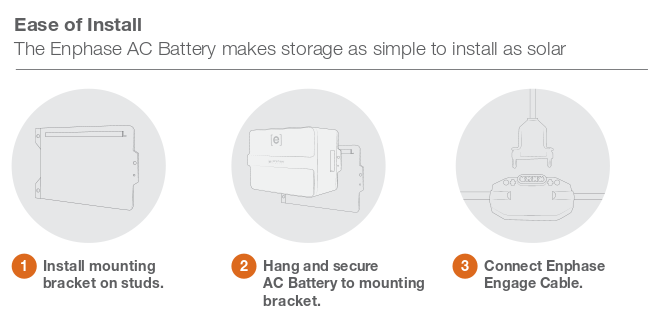Enphase Energy, a US-based energy technology company and the world’s largest manufacturer of microinverters, has recently announced that Australia will be the launching pad for its groundbeaking AC Battery, which will be available next year. The Enphase AC Battery is a modular, expandable energy storage solution worthy of the company that brought microinverter technology into the mainstream.
The Enphase AC Battery will offer a fresh approach to home energy storage – one unlike anything else on the market. Most storage systems are comprised simply of a battery bank and a battery or hybrid inverter, which converts the DC electrical energy (which the batteries store) into usable, appliance-friendly AC electricity.
Update Nov 2017: How much can you save with Enphase’s AC Batteries?
Storage systems may also come in the form of all-in-one, plug-and-play devices from a single manufacturer, or be designed by an engineer to use components from different manufacturers. The former are simple to design and install, while the latter are more flexible with regard to sizing and system layout. The innovative genius of Enphase’s AC Battery is that it combines the advantages of both types of systems: plug-and-play simplicity with a high degree of flexibility.
Enphase’s AC Battery contains a 1.2kWh LiFePO4 battery, an S-series microinverter and Enphase Enlighten communications software.
Compare Solar & Battery QuotesEach Enphase AC Battery unit contains a 1.2 kilowatt-hour (kWh) lithium-ion phosphate (LiFePO4) battery, an Enphase S-series microinverter and Enphase’s Enlighten communications software. Units can be easily mounted onto a wall with a single set of hands in any number of configurations and arrangements – and more units may be added as necessary, should the system require expansion in the future. This means that a home can install 4 units for a total of 4.8kWh of storage with the option to increase the capacity to 6kWh, 7.2kWh, 9.6kWh or more further down the road.
 Enphase AC Battery units can be installed on a wall in any number of configurations – and can be easily expanded in the future if necessary. or desired (Image via Enphase Energy.)
Enphase AC Battery units can be installed on a wall in any number of configurations – and can be easily expanded in the future if necessary. or desired (Image via Enphase Energy.)
Storage systems using Enphase’s AC Batteries are easy to design and install. (Image via Enphase Energy.)
From a homeowner’s perspective, the AC Battery highly appealing in that it allows them to size an energy storage system to suit their individual needs and budget. But it is the bigger picture applications that make it even more exciting: Enphase’s AC Batteries and their software help to facilitate greater uptake of solar on the electricity grid by rectifying some of the issues inherent with high solar PV penetration rates, including power quality stabilisation and protection against over-voltage in local networks.
Key benefits:
- Simple, modular and wall-mountable, the battery system can be arranged in a number of configurations and capacity sizes
- Easily expandable for growing energy needs
- Dependable, long-life and ultra-safe LiFePO4 battery chemistry with high depth of discharge (DoD)
- Intelligent energy management system helps to maximise utility bill savings and battery life
- Greater overall system resilience compared to conventional storage systems thanks to modularity and inverter redundancy. For example, one unit going offline will not impact other units.
- Highest round-trip efficiency at 96%
- 10+ year life with two cycles daily
- Seamless, whole-of-system communication and online monitoring accessible from anywhere with Enphase’s Enlighten software
Compare Solar & Battery Quotes
© 2015 Solar Choice Pty Ltd


If the grid fails can your system maintain supply? We have 20 Tindo panels with micro inverters. What capacity storage would be best and approximate cost. Thank you. Bryan and Olivia Ballard
Hi Olivia,
At this point, solar PV systems with Enphase microinverters cannot continue to supply power to your home due to ‘anti islanding’ safety measures (basically, someone working on the downed lines could be electrocuted). Some solar systems do continue to supply power even when the grid is down, but these systems usually have a central inverter with a backup circuit connected only to essential loads like lights and a fridge – but keep in mind that these are generally the exception rather than the rule.
As for battery capacity, it depends mainly on how much excess solar your system produces (i.e. how much it sends back into the grid). We are developing a battery storage system sizing tool which will soon be made available on our website (sign up for our newsletter by entering your email in the form on upper left-hand part of this page), but I am also aware that Enphase’s monitoring system can possibly make recommendations for battery size based on your consumption. I’d recommend getting in touch with either the installer of your system or Enphase directly to discuss whether this functionality is available to you.
Remember also that it may be possible to retrofit a non-Enphase battery bank onto your existing solar system. One advantage of doing so would be the possibility of accesses to backup power when the grid goes down – at present, Enphase’s AC Battery modules cannot supply backup power. You can check out a list of battery solutions available in Australia here. That being said, Enphase’s own batteries are more likely to integrate easily and seamlessly with your existing system than a 3rd party battery bank – so it really depends on what functions and capabilities you’re looking for.
Best of luck!